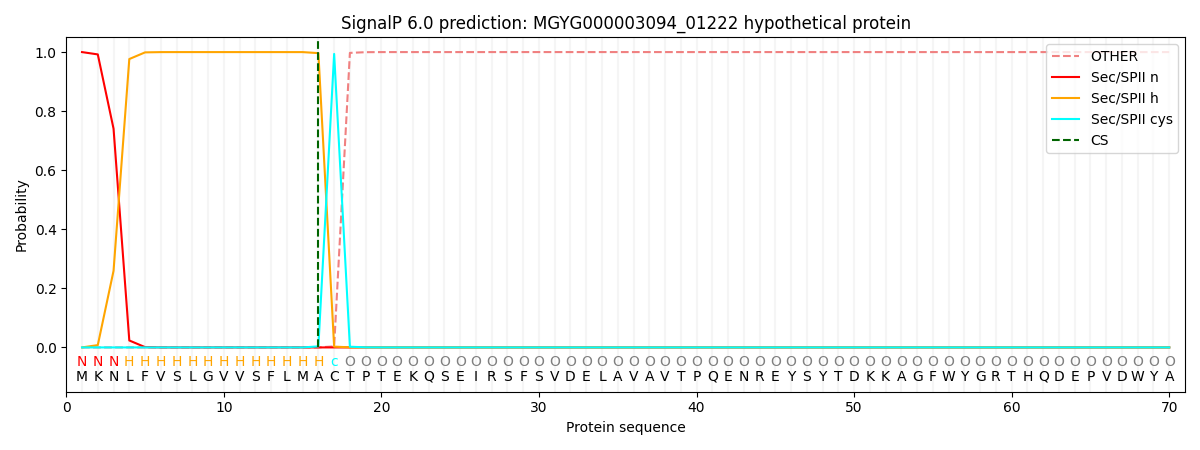You are browsing environment: HUMAN GUT
CAZyme Information: MGYG000003094_01222
You are here: Home > Sequence: MGYG000003094_01222
Basic Information |
Genomic context |
Full Sequence |
Enzyme annotations |
CAZy signature domains |
CDD domains |
CAZyme hits |
PDB hits |
Swiss-Prot hits |
SignalP and Lipop annotations |
TMHMM annotations
Basic Information help
| Species | Phocaeicola barnesiae | |||||||||||
|---|---|---|---|---|---|---|---|---|---|---|---|---|
| Lineage | Bacteria; Bacteroidota; Bacteroidia; Bacteroidales; Bacteroidaceae; Phocaeicola; Phocaeicola barnesiae | |||||||||||
| CAZyme ID | MGYG000003094_01222 | |||||||||||
| CAZy Family | GH133 | |||||||||||
| CAZyme Description | hypothetical protein | |||||||||||
| CAZyme Property |
|
|||||||||||
| Genome Property |
|
|||||||||||
| Gene Location | Start: 19162; End: 21318 Strand: + | |||||||||||
CAZyme Signature Domains help
| Family | Start | End | Evalue | family coverage |
|---|---|---|---|---|
| GH133 | 260 | 614 | 1.6e-63 | 0.9838709677419355 |
CDD Domains download full data without filtering help
| Cdd ID | Domain | E-Value | qStart | qEnd | sStart | sEnd | Domain Description |
|---|---|---|---|---|---|---|---|
| pfam06202 | GDE_C | 4.86e-78 | 257 | 614 | 11 | 374 | Amylo-alpha-1,6-glucosidase. This family includes human glycogen branching enzyme AGL. This enzyme contains a number of distinct catalytic activities. It has been shown for the yeast homolog GDB1 that mutations in this region disrupt the enzymes Amylo-alpha-1,6-glucosidase (EC:3.2.1.33). |
| COG3408 | GDB1 | 5.46e-48 | 216 | 656 | 222 | 638 | Glycogen debranching enzyme (alpha-1,6-glucosidase) [Carbohydrate transport and metabolism]. |
| TIGR01531 | glyc_debranch | 1.51e-12 | 195 | 617 | 951 | 1462 | glycogen debranching enzymye. glycogen debranching enzyme possesses two different catalytic activities; oligo-1,4-->1,4-glucantransferase (EC 2.4.1.25) and amylo-1,6-glucosidase (EC 3.2.1.33). Site directed mutagenesis studies in S. cerevisiae indicate that the transferase and glucosidase activities are independent and located in different regions of the polypeptide chain. Proteins in this model belong to the larger alpha-amylase family. The model covers eukaryotic proteins with a seed composed of human, nematode and yeast sequences. Yeast seed sequence is well characterized. The model is quite rigorous; either query sequence yields large bit score or it fails to hit the model altogether. There doesn't appear to be any middle ground. [Energy metabolism, Biosynthesis and degradation of polysaccharides] |
| pfam17389 | Bac_rhamnosid6H | 2.56e-05 | 278 | 454 | 44 | 213 | Bacterial alpha-L-rhamnosidase 6 hairpin glycosidase domain. This family consists of bacterial rhamnosidase A and B enzymes. L-Rhamnose is abundant in biomass as a common constituent of glycolipids and glycosides, such as plant pigments, pectic polysaccharides, gums or biosurfactants. Some rhamnosides are important bioactive compounds. For example, terpenyl glycosides, the glycosidic precursor of aromatic terpenoids, act as important flavouring substances in grapes. Other rhamnosides act as cytotoxic rhamnosylated terpenoids, as signal substances in plants or play a role in the antigenicity of pathogenic bacteria. |
CAZyme Hits help
| Hit ID | E-Value | Query Start | Query End | Hit Start | Hit End |
|---|---|---|---|---|---|
| QUT90346.1 | 3.41e-258 | 6 | 656 | 17 | 667 |
| QDO71213.1 | 1.15e-256 | 6 | 656 | 17 | 667 |
| ALJ58547.1 | 3.75e-255 | 6 | 656 | 17 | 667 |
| QCD35869.1 | 2.64e-254 | 3 | 656 | 5 | 663 |
| QNE40753.1 | 5.93e-226 | 1 | 681 | 1 | 692 |
Swiss-Prot Hits help
SignalP and Lipop Annotations help
This protein is predicted as LIPO

| Other | SP_Sec_SPI | LIPO_Sec_SPII | TAT_Tat_SPI | TATLIP_Sec_SPII | PILIN_Sec_SPIII |
|---|---|---|---|---|---|
| 0.000000 | 0.000000 | 1.000052 | 0.000000 | 0.000000 | 0.000000 |
